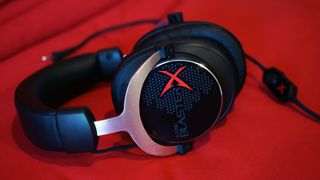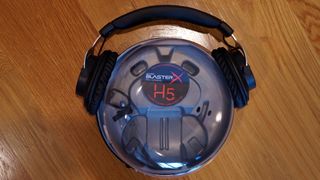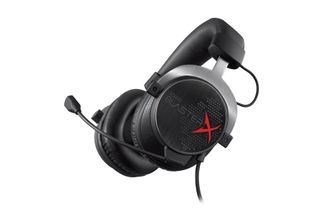The Sound BlasterX H5 may be my favorite gaming headset of the year

Every time I think I’ve discovered a flaw with Creative’s Sound BlasterX H5 headset, I dig a little deeper and discover a strength, instead. After a week and a half of testing the H5 against my Sennheiser 598 headphones, it’s been difficult for me to spot many weaknesses in Creative’s newest gaming headset. It sounds fantastic, nearly as good as my more expensive cans. It’s light and comfortable for multiple hours of wear. It’s durable, with a bendable steel frame. And it has a detachable mic that manages to cut out background noise and capture clear, quality voice.
If you're sick of the trend of gaming headsets piling on RGB LEDs to bump up the price—and I am—pay attention to the H5. It’s a no-nonsense, high quality analog headset, and the first pair of cans I’ve tested this year that I think might usurp the Kingston HyperX Cloud as our favorite gaming headset. Right now, its only real drawback is a launch MSRP of $130, but that’s unlikely to be the price it settles at when Amazon has the headset in stock.
The design of the BlasterX H5 is a big step up from Creative’s older headsets, like the plasticky Recon3D Omega. It’s surprisingly light given its steel frame, and even after a couple hours never put too much pressure on my hears or the top of my head. The steel frame is also extremely bendable—you can bend it completely flat without damaging it or disturbing its shape. The earcups don’t rotate, so they’re not perfect travel cans, but they have a nice loose swivel that feels sturdy and adjusts well to my head.
That design doesn’t much matter if the sound quality isn’t up to snuff, but to my ears the H5 sounds fantastic playing through a Sound Blaster X7 USB DAC. I have my Sennheiser 598s plugged into that same DAC, and alternated between the two headsets while listening to FLACs and playing a few games. I definitely don’t have the most discerning ears, and I’m sure I'm missing out on some subtleties that hardcore audiophiles would spot between the two headsets. Having said that, it was often hard for me to perceive a difference between the two. I’d describe the Sennheisers as sounding slightly more open and full, but switching between the two I never noticed a dramatic difference. It makes sense that the Sennheiser’s would sound slightly more open, since the 598s are open-back headphones. The H5 is a “ported” closed design, which Creative says provides a bit more bass punch without sound leakage.

The Sennheiser headset is a bit louder, but I never bumped my system volume up over the halfway mark for either, so the H5s can certainly get plenty loud.
Early in my testing, I thought the H5 sounded terribly muffled and tinny; turns out the detachable cable into the earcup, which is only supposed to fit in one way, half-fit in the other direction, and I had it plugged in improperly. It obviously sounded much, much better when the 3.5mm jack was properly in place. I also thought the headset’s bass was on the weaker side, but once I equalized volume with the Sennheiser 598s I found the H5 to be a tiny bit bassier (admittedly, the 598s aren’t known for strong bass performance). Overall the H5 sounds well-balanced, without highs, mids or lows standing out as being exceptional or poor.
I thought the mic might be another weakness for the headset, since most of the gaming headsets I’ve used in the past have had fairly poor-sounding microphones. To test the mic, I got on chat client Mumble with PC Gamer editor James and spent a few minutes talking, with and without a podcast playing out of a portable speaker behind me. The mic came through clearly, and when the podcast was playing at a comfortable room volume, it was detectable only as faint white noise. Even when I turned the microphone 180 degrees to face the speaker which was about a meter away, it only came through faintly, meaning the mic’s audio is pretty localized.
PC Gamer Newsletter
Sign up to get the best content of the week, and great gaming deals, as picked by the editors.
As a comparison, I switched to chatting with a unidirectional $50 Antlion ModMic, expecting there to be a significant difference between the two. To my surprise, James reported the sound quality very similar—slightly better with the ModMic, but only slightly. With the podcast playing, the ModMic didn’t show even a hint of background noise. When I rotated the mic to point at the speaker, James could hear the same low background murmur as with the other mic.

The one area where the H5 falls a bit short is with its optional Acoustic Engine Lite software. Creative told me feedback from users has shown them that few people will drill down into audio settings to change how a headset sounds, and that feedback dictated the very basic tweaking options in the software. There are presets for four different game types, and ‘effects off.’ That’s it. Those profiles affect Surround, Crystalizer, Bass, Smart Volume, and Dialogue Plus settings, but those values aren’t individually tweakable in the software. I tested the FPS setting, which enabled virtual surround sound and amped up game sound effects, and wasn’t particularly fond of the virtual surround implementation or the unbalanced audio with over-loud sound effects. To tweak sound values, you’ll have to use a different software equalizer.
The H5 is an over-ear headset, but it isn’t noise-canceling. With the headset on at a reasonable volume I was able to hear sound in the room around me. I think this is a good thing—I like some awareness of my surroundings when I’m wearing a headset, generally—but if you want to completely seal out the outside world, you may want something with a tighter seal.
I need to test the H5 directly against Kingston’s HyperX Cloud, but so far they’re my favorite new cans of the year. Creative has a higher-end model launching soon, the 7.1 surround USB H7, but I think the H5 will hit the sweet spot for anyone looking for an analog headset with great sound quality—especially if the retail price drops down to a more competitive $100.

Wes has been covering games and hardware for more than 10 years, first at tech sites like The Wirecutter and Tested before joining the PC Gamer team in 2014. Wes plays a little bit of everything, but he'll always jump at the chance to cover emulation and Japanese games.
When he's not obsessively optimizing and re-optimizing a tangle of conveyor belts in Satisfactory (it's really becoming a problem), he's probably playing a 20-year-old Final Fantasy or some opaque ASCII roguelike. With a focus on writing and editing features, he seeks out personal stories and in-depth histories from the corners of PC gaming and its niche communities. 50% pizza by volume (deep dish, to be specific).
Most Popular

